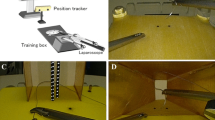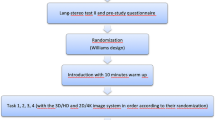Abstract
Background
Three-dimensional (3-D) high-definition (HD) stereovision and two-dimensional (2-D) ultra-high-resolution (4K) monitors have recently become available for laparoscopic surgery. The aim of this study was to compare laparoscopic performance between inexperienced participants using 3-D/HD and 2-D/4K monitors and those using conventional 2-D/HD monitors.
Methods
The study enrolled 66 participants with no previous surgical experience or medical training. They were randomly divided into three equal groups, each using a different type of monitor (2-D/HD, 2-D/4K, or 3-D/HD), to perform three phantom tasks using a laparoscopic simulator: Task 1, touching markers on a non-flat surface; Task 2, bimanual peg transfer; and Task 3, passing a straight rod through a loop. Each task was performed three times. The performance scores (operative time, path length of the forceps, and technical errors) were compared for each monitor type and by age group (< 30 vs. > 30 years).
Results
For all three tasks, scores using the 3-D monitor were significantly better than those using either 2-D monitor, with no difference between the 2-D/4K and 2-D/HD monitors. Using the 2-D monitors, the performance of Task 3 by the participants > 30 years was worse than that by the younger participants; however, there was no difference between the age groups when using the 3-D monitor.
Conclusion
Participants with no prior experience using a 3-D monitor showed better laparoscopic performance than those using 2-D monitors, even with 4K resolution. This improvement was more marked in older participants, suggesting a greater loss of depth perception in a 2-D environment.





Similar content being viewed by others
References
Harada H, Kanaji S, Nishi M, Otake Y, Hasegawa H, Yamamoto M, Matsuda Y, Yamashita K, Matsuda T, Oshikiri T, Sumi Y, Nakamura T, Suzuki S, Sato Y, Kakeji Y (2018) The learning effect of using stereoscopic vision in the early phase of laparoscopic surgical training for novices. Surg Endosc 32:582–588
Nishi M, Kanaji S, Otake Y, Harada H, Yamamoto M, Oshikiri T, Nakamura T, Suzuki S, Suzuki Y, Hiasa Y, Sato Y, Kakeji Y (2017) Quantitative comparison of operative skill using 2- and 3-dimensional monitors during laparoscopic phantom tasks. Surgery 161:1334–1340
Harada H, Kanaji S, Hasegawa H, Yamamoto M, Matsuda Y, Yamashita K, Matsuda T, Oshikiri T, Sumi Y, Nakamura T, Suzuki S, Kakeji Y (2018) The effect on surgical skills of expert surgeons using 3D/HD and 2D/4K resolution monitors in laparoscopic phantom tasks. Surg Endosc 32:4228–4234
Abdelrahman M, Belramman A, Salem R, Patel B (2018) Acquiring basic and advanced laparoscopic skills in novices using two-dimensional (2D), three-dimensional (3D) and ultra-high definition (4K) vision systems: a randomized control study. Int J Surg 53:333–338
Chiu CJ, Prabhu KL, Tan-Tam CC, Panton ON, Meneghetti A (2015) Using three-dimensional laparoscopy as a novel training tool for novice trainees compared with two-dimensional laparoscopy. Am J Surg 209:824–827
Egi H, Hattori M, Suzuki T, Sawada H, Kurita Y, Ohdan H (2016) The usefulness of 3-dimensional endoscope systems in endoscopic surgery. Surg Endosc 10:4562–4568
Poudel S, Kurashima Y, Watanabe Y, Ebihara Y, Tamoto E, Murakami S, Nakamura T, Tsuchikawa T, Okamura K, Shichinohe T, Hirano S (2017) Impact of 3D in the training of basic laparoscopic skills and its transferability to 2D environment: a prospective randomized controlled trial. Surg Endosc 31:1111–1118
Arezzo A, Vettoretto N, Francis NK, Bonino MA, Curtis NJ, Amparore D, Arolfo S, Barberio M, Boni L, Brodie R, Bouvy N, Cassinotti E, Carus T, Checcucci E, Custers P, Diana M, Jansen M, Jaspers J, Marom G, Momose K, Müller-Stich BP, Nakajima K, Nickel F, Perretta S, Porpiglia F, Sánchez-Margallo F, Sánchez-Margallo JA, Schijven M, Silecchia G, Passera R, Mintz Y (2019) The use of 3D laparoscopic imaging systems in surgery: EAES consensus development conference 2018. Surg Endosc 33:3251–3274
Zhou J, Xu HJ, Liang CZ, Zhang L, Hao ZY, Feng LX (2015) A comparative study of distinct ocular symptoms after performing laparoscopic surgical tasks using a three-dimensional surgical imaging system and a conventional two-dimensional surgical imaging system. J Endourol 29:816–820
Schiller PH, Kendall GL, Kwak MC, Slocum WM (2012) Depth perception, binocular integration and hand-eye coordination in intact and stereo impaired human subjects. J Clin Exp Ophthalmol 3:210
Bosten JM, Goodbourn PT, Lawrance-Owen AJ, Bargary G, Hogg RE, Mollon JD (2015) A population study of binocular function. Vis Res 110:34–50
Fergo C, Burcharth J, Pommergaard HC, Rosenberg J (2016) Age is highly associated with stereo blindness among surgeons: a cross-sectional study. Surg Endosc 30:4889–4894
Acknowledgments
The authors would like to thank the staff at IRCAD and other volunteers who participated in this study. Medical English proofreading by Iana Shutrova has been a valuable help with the manuscript revision. We would also like to thank Olympus Corporation Europe for kindly lending us the 3-D/HD and 2-D/4K laparoscopic systems for the purposes of this study.
Author information
Authors and Affiliations
Corresponding author
Ethics declarations
Disclosures
Jacques Marescaux is the President of both IRCAD and IHU Institutes, which are partly funded by KARL STORZ, Medtronic, and Siemens Healthcare. Shingo Kanaji, Ryohei Watanabe, Pietro Mascagni, Fabian Trauzettel, Takeshi Urade, Fabio Longo, Ludovica Guerriero, Silvana Perretta, Bernard Dallemagne, and Yoshihiro Kakeji have no conflict of interest or financial ties to disclose.
Additional information
Publisher's Note
Springer Nature remains neutral with regard to jurisdictional claims in published maps and institutional affiliations.
Rights and permissions
About this article
Cite this article
Kanaji, S., Watanabe, R., Mascagni, P. et al. Three-dimensional imaging improved the laparoscopic performance of inexperienced operators: a prospective trial. Surg Endosc 34, 5083–5091 (2020). https://doi.org/10.1007/s00464-019-07308-6
Received:
Accepted:
Published:
Issue Date:
DOI: https://doi.org/10.1007/s00464-019-07308-6




